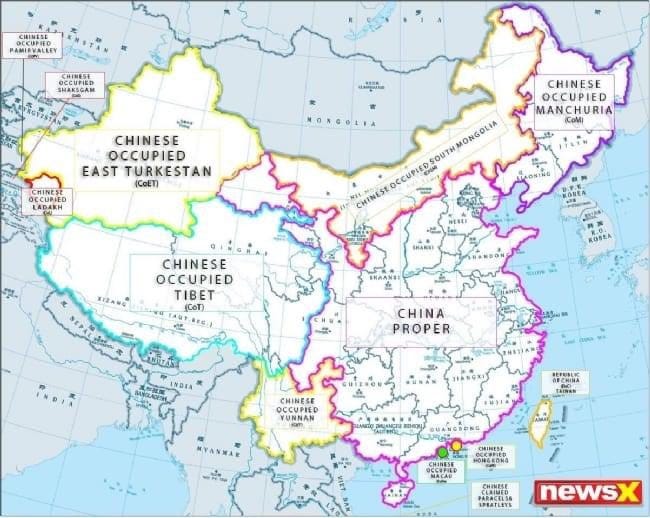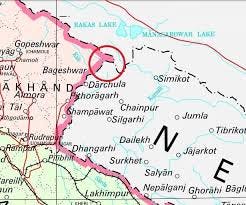Cartographic Terrorism
The China model infects first Nepal, then Pakistan

After China’s too-clever-by-half tactic of using dubious ‘historial’ ‘facts’ to lay claim to territory, it seems to have instructed its friends Nepal and Pakistan to do the same to India. There is no reason for India to treat this as anything but an absurd land-grab and to push back.
At its core is a distinctly imperialist idea: “What’s mine is mine; what’s yours is negotiable”. Thus China is a revanchist power, constantly coveting others’ territory in its search for—and that seems to be most accurate term, with all its implications—lebensraum.
China has been infamous for fabricating ‘evidence’ about its historical [sic] claims. We have seen this, for example, in the South China Sea, where, contrary to all actual facts on the ground, China produced an old map with a ‘nine-dash line’ that suggests that the sea is virtually a Chinese lake, and it has then proceeded to assert claims to it.
This is cartographic assault, and falls afoul of the law (UN Convention on the Law of the Seas, UNCLOS), which China is a party to. In fact, in the one case that has been adjudicated, the Philippines was awarded a unanimous verdict by the court of arbitration, which held that China had unlawfully encroached on Filipino territory.
That, of course, hasn’t stopped China, which has pursued its usual salami-slicing tactics not only in the South China Sea, but also in the East China Sea, in Ladakh and Arunachal Pradesh against India, but most appallingly in Chinese-occupied Tibet (CoT) and Chinese-occupied Xinjiang (CoX), two of several territories it conquered.

In reality, the core Han homeland is as seen in this map (courtesy Wikipedia) of Chiang Kai-Shek regime’s domain: just a few territories on the eastern seaboard (that they, not very successfully, tried to defend by building the Great Wall of China), not including Manchuria, which, under the Manchu Empire, in fact had been ruling the Han regions until the early part of the 20th century.
There are many atrocious examples of myth-making, and another imperial meme that they use: “truth by repeated assertion”. By insistently repeating the same lie, they eventually convince people it is the truth. Incidentally, that’s a perfect example of some of of Goebbels’ principles of propaganda (courtesy Propagation and Persuasion; Jowett & O'Donnell):
Avoid abstract ideas - appeal to the emotions.
Constantly repeat just a few ideas. Use stereotyped phrases.
This technique can be seen in the saga of the Zheng He voyages. The man (supposedly a Hui Muslim from Yunnan) and the voyages have grown steadily in the retelling. What was probably a small group of ships has been transformed into a giant armada, an all-conquering fleet that toured (conquered?) much of the Indian Ocean (all the better to make future territorial claims to all the ports that the ships allegedly visited).
It is almost certain that nobody has any idea of the actual ships that Zheng He’s mythical voyage used, partly because China turned inward and ceaseful to be a maritime power a few centuries ago.
But in case you want to experience what they were allegedly like, you just have to go Singapore’s SEA Aquarium: and there you can board a 'scale model’ [sic] of a Zheng He ship, and there’s a 5-d sound and light show where you can feel the spray of the sea, and how it feels when the ship is in a storm. Convincing. Good brainwashing.
Now this technique of make-believe has been extended to Nepal as well. As is well known, Nepal has been the subject of a sly take-over by communists ever since King Birendra and family were massacred. I predicted at the time, in 2005, that disaster would befall the only Hindu kingdom in the world, and so it has.
Now, ironically, China is nibbling away at Nepalese territory on the one hand, and encouraging the pro-China Prime Minister Oli to claim Indian territory on the other hand. The map below (courtesy India Today) shows the Kalapani area of Uttarakhand that Nepal now claims, along with several other strips of land.
It is interesting that this area is very close to Manasarovar and Mt. Kailas, so holy to Hindus. In fact, why shouldn’t India now start claiming those parts of Tibet as its own territory? Moreover, there are clear historical facts that Xinjiang was (before it was Islamicized) a Hindu territory, according to the scholar Subhash Kak.
India should make territorial claims to both Tibet and Xinjiang, based on its own historical rationale, to take a leaf out of the Chinese book. And then perhaps provide material and moral support to dissenters and separatists, as China does in India’s Northeast/Kashmir and all over India’s mainstream media and universities.

Now Pakistan has also stepped in. On August 4th, it released a new map (courtesy AllGujaratNews.in) that showed Jammu and Kashmir, including Ladakh as part of its territory (but not Aksai Chin; no prizes for guessing why), as well Junagadh and Sir Creek. I am surprised it did not claim the erstwhile Hyderabad kingdom as well, or Lakshadweep or Malabar. Maybe that’s yet to come.

Two can play at this game. India should do two things: first, recognize the Tibetan Government in exile as the legitimate representative of the aspirations of the people of Tibet, and reverse the tame acceptance of Chinese suzerainty over this historically Indic land by any and all means, eg. marking Tibet as a separate territory from China in all its maps, as well as awarding the Bharat Ratna to HH the Dalai Lama.
The other thing India needs to do forthwith is to elevate its relationship with Taiwan and recognize the island nation. There is the interesting story of the territory of Somaliland (a breakaway area of Somalia) recognizing Taiwan. Rumor has it that the ‘wolf warrior’ diplomats of China so incensed the Somaliland leader that he immediately decided to snub them. If a tiny, not-fully-formed state like Somaliland can be bold enough to recognize Taiwan, surely India can too.
1000 words, Aug 6, 2020

India needs to retaliate to China more firmly and squarely and boycott China in all ways possible.
My expectation, based on history, is that we will take none of the steps you suggest. We are too goody-goody and pusillanimous a nation.